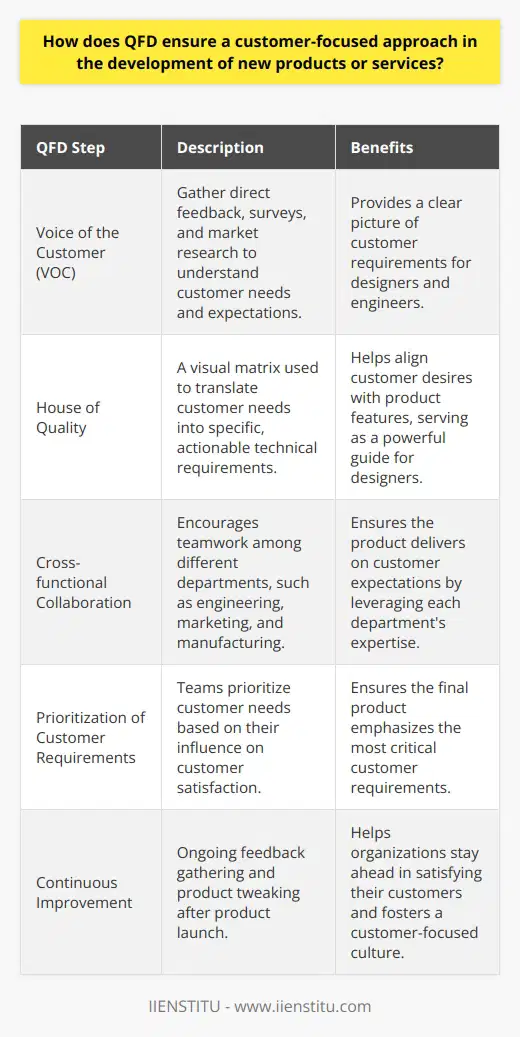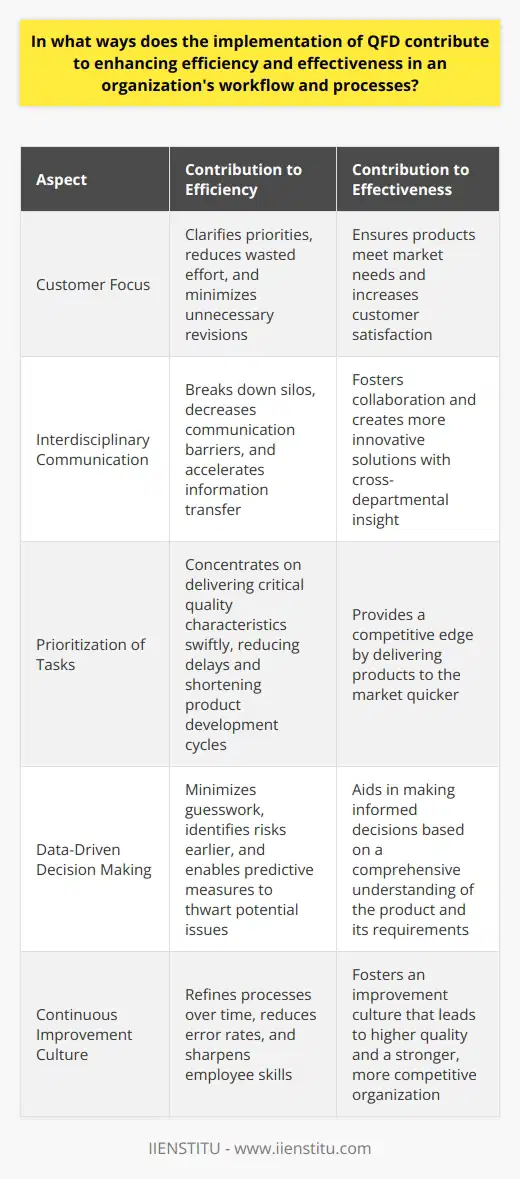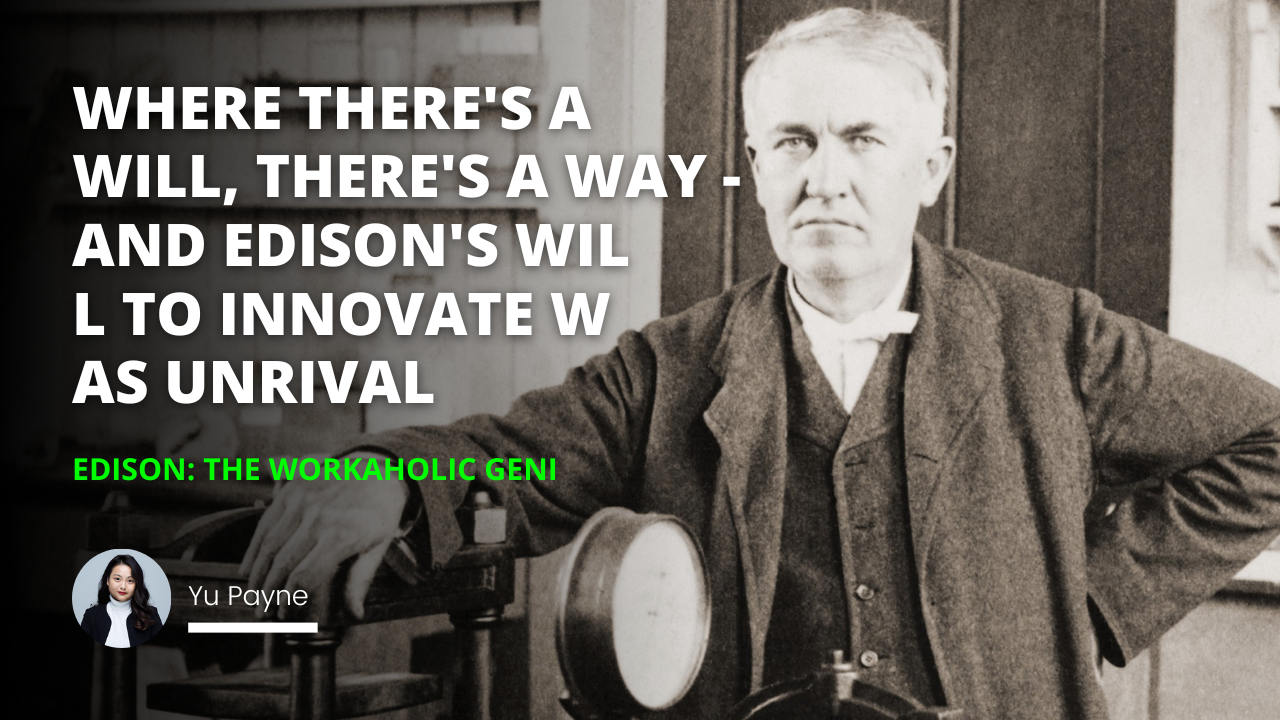
Quality Function Deployment (QFD) is a structured approach to designing and delivering products and services that align with customer desires and expectations. By transforming customer needs into clear action and design attributes, QFD serves as a bridge between consumers and producers. In the modern industrial landscape, rife with competition and continuous innovation, QFD emerges as a vital tool, enabling organizations to prioritize their efforts and resources effectively, thus leading to enhanced customer satisfaction and business performance. This article strives to delve deep into the nuanced concepts of QFD, unveiling its strategic impact and dissecting its multifaceted implementation.
Understanding the Concept of QFD
QFD is grounded in the philosophy that products should be designed to reflect customers' desires and needs. To make this possible, the QFD process functions as a translator of customer requirements into design targets and quality benchmarks throughout the product development lifecycle. An expert in the field would recognize that QFD is not merely a tool but a comprehensive, multi-disciplinary approach that necessitates deep customer understanding and robust cross-functional collaboration.
The cornerstone of QFD lies in its emphasis on customer requirements. These are captured and categorized meticulously, often with a focus on the Voice of the Customer (VoC), which serves as the guiding light for the entire development process. Collecting this data is a rigorous activity, often necessitating direct interaction with customers through interviews, surveys, and focus groups, thus ensuring the voice captured represents genuine customer sentiments.
QFD does not exist in isolation; rather, it correlates with other quality techniques such as Six Sigma, Lean, and Total Quality Management (TQM). Integrating QFD into an array of quality control methods enhances its holistic nature, fostering efficient product development processes that are lean and customer-centric. Organizations that successfully marry QFD with these methodologies often see marked improvements in quality and customer satisfaction.
The Four Phases of QFD
The Product Planning Phase
The initial stage of QFD, the product planning phase, begins with a meticulous identification of customer requirements. Teams engage in collecting detailed customer feedback and structuring these into hierarchical needs, which are often manifested in the form of a "House of Quality" matrix. This matrix serves as the foundational step in translating nebulous customer desires into concrete, measurable product features.
Accurate translation is key; each customer requirement must be associated with corresponding technical descriptors that provide a quantifiable means of assessing whether the product design truly meets customer expectations. This dialectic between customer needs and design features is foundational, necessitating iterative refinement to ensure alignment.
The Product Design Phase
During the product design phase, QFD takes on a more substantive role in molding the product concept. Developing potential product concepts is often an iterative process involving creativity and structured analysis. Teams explore a variety of ideas, diligently assessing each against the mirrors of technical feasibility and customer desire.
Selecting the best product concept from the myriad possibilities is no trivial task. It requires a confluence of strategic foresight, market knowledge, and technical expertise. The selected concept will be one that best delivers on the customer's voice while maintaining design integrity and feasibility.
The Process Planning Phase
In the third quarter of the QFD journey, the focus shifts to process planning. Here teams determine the specific process steps required to produce the product, ensuring that these steps can reliably reproduce the quality levels that customers expect. Every aspect of the production process is scrutinized against the customer's requirements, with a consistent emphasis on achieving high quality with minimal waste.
The teams evaluate the process capability and adjust workflows to deal with potential variability, aiming to construct a robust manufacturing process that will consistently deliver to customer specifications. In essence, the essence of the QFD process planning phase is to translate design reliability into production consistency.
The Production Planning Phase
Rounding out the QFD approach is the production planning phase, where detailed plans are devised to anticipate and address potential issues that might arise during the actual production. Risk assessments, continuous improvement strategies, and contingency planning are all keystrokes in this stage.
At this juncture, it is also critical to institute rigorous monitoring and control processes to ensure that deviations from the product requirements are identified and rectified promptly. The feedback loop created here not only perfects the current project but also informs future QFD efforts, cycling back to the tenet of relentless improvement.
Implementation of QFD
Embarking on a QFD project requires careful preparation, beginning with articulating project objectives and securing strong executive support. Clarity in goals ensures that all QFD activities are geared toward a unified vision, whereas executive backing provides the necessary resources and ensures organizational alignment.
The execution of a QFD project is a sequence of incremental, interlinked steps that build upon one anothersuch as capturing customer voices, developing design concepts, and detailing production processesguided by the QFD matrixes. At every juncture, decisions are data-driven, rooted in customer insights, and calibrated against technical capabilities.
Role of a QFD Team
A QFD project is typically led by a cross-functional team, drawing expertise from different departments such as marketing, design engineering, and manufacturing. Each team member contributes unique insights, helping to build a well-rounded and robust approach to product development.
However, QFD implementation is not without challenges. These may vary from misalignment of team members to inadequate customer knowledge, leading to misprioritized features or even project failures. To overcome such obstacles, it's imperative to foster a culture of open communication, ongoing project management, and continual learning. Anecdotes from successful QFD projects often highlight the necessity of addressing these challenges head-on with creativity and dedicated problem-solving.
The Benefits and Limitations of QFD
Benefits of Implementing QFD in an Organization
Organizations that implement QFD can look forward to myriad benefits. Chief among these is the alignment of products and services with customer preferences, which engenders increased customer satisfaction and loyalty. Moreover, because QFD facilitates clear communication across different departments, it can lead to better cross-functional collaboration and more efficient resource utilization.
Real-world examples of successful QFD implementation are numerous and span various industries. Companies like Toyota and Xerox have been known to deploy QFD to great effect, integrating customer feedback into their product development cycles and achieving substantial market success as a result.
Potential Limitations and Critiques of QFD
Despite its benefits, QFD is not a panacea and does face criticisms. Some argue that it can be overly complex and time-consuming, which may not be suitable for every company or project. Others point out that it requires a significant cultural and organizational commitment, which may be challenging for some to achieve.
Critiques of QFD often revolve around issues of scalability and adaptability. However, these limitations can often be mitigated through careful planning and implementation, as well as tailoring the QFD process to the specific needs and circumstances of the organization.
The Future of QFD
Evolving Developments in the QFD Technique
As businesses evolve and customer demands become ever more complex, the QFD technique is also adapting. Embracing digital tools and data analytics is enhancing its precision and speed, allowing for more nuanced and sophisticated interpretations of customer data.
Moreover, the integration of QFD with sustainability goals and the rising ethos of social responsibility is likely to be an area of growth. The ability to design for not just functional quality but also environmental and social impact is expanding the QFD framework and its strategic relevance.
Predictions and Implications for the Future of QFD
The future of QFD appears promising as it continues to intertwine with technological advancements.
Predictions for QFD include a greater focus on global trends such as the Internet of Things (IoT) and smart manufacturing processes, which will enable even closer synchronization between customer needs and product offerings. In the wave of big data, QFD's ability to cut through the noise and laser-focus on actionable customer insights will be invaluable.
Conclusion
The exploration of Quality Function Deployment reveals it as a pivotal component in the strategic toolkit for modern organizations. The methodical alignment with customer needs that QFD facilitates is a cornerstone of competitive advantage. Given the dynamic changes in customer preferences and the pace of technological innovation, the continued research and application of QFD are not just beneficial but essential for organizations aspiring to maintain relevance and excellence.
Professionals interested in mastering this influential methodology may find value in pursuing a problem solving certificate, particularly through online certificate programs that specialize in quality management disciplines. Endowed with comprehensive knowledge and a commitment to user-centered design, a professional well-versed in QFD strategies is better positioned to make meaningful contributions to product development and thus the overall success of an organization.
Frequently Asked Questions
What is the strategic importance of Quality Function Deployment in product development and management?
Understanding Quality Function Deployment
Quality Function Deployment (QFD) stands as a systematic approach. It integrates customer requirements with company capabilities. QFD focuses on customer satisfaction. This translates into competitive advantage.
The Role of QFD in Product Development
QFD ensures customer voices shape products. It turns customer desires into design targets. This applies throughout the product lifecycle. Teams understand what matters most to customers. QFD reduces the risk of product-market misalignment.
The tool streamlines communication. It breaks down silos between departments. Cross-functional dialogue grows stronger. Everyone sees the big picture. This collaboration pushes innovation. QFD fosters a culture of shared goals.
Enhancing Product Management with QFD
QFD serves as a planning tool. It prioritizes features based on customer values. This allows for strategic resource allocation. Teams focus on high-impact attributes. This leads to efficient use of time and costs.
It offers a quantifiable method to track progress. Metrics and benchmarks guide development. This clarity aids in performance evaluation. Teams can adjust strategies with solid data.
Strategic Benefits of Implementing QFD
- Enhances customer satisfaction: Directly addresses user needs.
- Reduces time to market: Streamlines the development process.
- Improves product quality: Aligns output with expectations.
- Cuts costs: Prevents overengineering and misdirected efforts.
- Encourages team unity: Provides a common reference point.
Conclusion
QFD transforms customer insights into tangible products. It aligns multidisciplinary efforts towards value creation. In strategic product management, QFD acts as a guide. It ensures decisions reflect customer priorities. Effective deployment of QFD can cement a company's market position. It anchors product development in customer-centric innovation.

How does QFD ensure a customer-focused approach in the development of new products or services?
Understanding QFD in Product Development
Quality Function Deployment (QFD) stands out as an organized approach that ensures customer satisfaction takes the lead in crafting new products or services. This method integrates customer requirements with business goals. It also aligns the intricate aspects of product development with market expectations.
Customer Voice Takes Center Stage
QFD begins with listening. It emphasizes gathering the customer’s voice. This produces a list called the voice of the customer (VOC). Direct feedback, surveys, and market research contribute here. With VOC, designers and engineers have a clear picture of customer needs.
Turning Needs into Specifications
The next step involves translating these needs. Specialists in QFD transform what customers express into specific, actionable technical requirements. They use the House of Quality, a visual matrix, to manage this. Designers find this matrix a powerful guide for aligning customer desires with product features.
Encouraging Cross-functional Collaboration
QFD fosters teamwork. Different departments—the likes of engineering, marketing, and manufacturing—must collaborate. Each brings its expert perspective. They together ensure the product delivers on customer expectations.
Prioritizing Customer Requirements
Not all customer desires hold equal weight. QFD tasks teams to prioritize. They figure out which needs bear the most influence on customer satisfaction. These top the priority list. This ensures the final product emphasizes them.
Consistent Reality Checks
The process entails constant reality checks. Engineers and designers must keep verifying whether their efforts align with customer expectations. Adjustments are routine.
Reducing Missteps and Waste
By focusing sharply on customer needs, QFD cuts back on mistakes. It reduces waste that arises from misaligned product features. Practically, this means fewer revisions and a speedier time to market.
Building a Customer-Focused Culture
Adopting QFD fosters a culture that values customer feedback. This mindset permeates the entire organization. It prompts a continuous loop of receiving and integrating consumer input.
Continuous Improvement
QFD does not stop at product launch. It urges ongoing feedback gathering and product tweaking. This mindset helps organizations stay ahead in satisfying their customers.
In summary, QFD ensures businesses keep their eyes on the prize—customer satisfaction. It aids in bringing forth products or services that align with consumer needs and expectations. This systematic approach champions the customer at every stage of the product's lifecycle.

In what ways does the implementation of QFD contribute to enhancing efficiency and effectiveness in an organization's workflow and processes?
Quality Function Deployment and Organizational Performance
Quality Function Deployment (QFD) is a structured approach. It translates customer requirements into relevant company processes. The tool fosters a customer-focused development cycle. Its implementation enhances both efficiency and effectiveness. These improvements occur across various organizational workflows.
QFD Boosts Efficiency Through Clear Direction
QFD clarifies customer expectations. It provides a roadmap for product development. Teams understand what to prioritize. This clarity reduces wasted effort. It minimizes the risk of unnecessary revisions. Resources are allocated more wisely. Teams concentrate on high-value activities. These activities lead directly to customer satisfaction.
Enhancing Effectiveness with Customer-Centric Insights
A customer-centric strategy emerges through QFD. This strategy ensures products meet market needs. Teams focus on features that matter to the consumer. Continuous feedback loops are established. They allow for real-time adjustments. These adjustments align products more closely with customer desires. Effectiveness increases as customer satisfaction does.
Streamlining Communication and Reducing Silos
QFD fosters interdisciplinary communication. Cross-functional teams collaborate more effectively. Silos break down. Everyone understands the desired outcome. A shared vision guides decision-making. Communication barriers decrease. Information transfer accelerates. Collaboration creates more innovative solutions. These solutions are crafted with cross-departmental insight.
Prioritizing Tasks and Reducing Time to Market
Time to market speeds up with QFD. Teams know the critical quality characteristics. They concentrate on delivering these swiftly. Delays decrease. Product development cycles shorten. The market receives products quicker. The organization benefits from a competitive edge.
Comprehensive Understanding Leads to Informed Decision-making
QFD provides comprehensive product insight. This insight aids data-driven decisions. Teams base actions on holistic understanding. Guesswork minimizes. Risks identify earlier. Predictive measures are possible. They thwart potential issues. The organization operates more strategically. Efficiency and effectiveness are heightened.
Continuous Improvement as a Culture
With QFD, continuous improvement becomes second nature. Each project teaches lessons. These lessons integrate into future cycles. Processes refine over time. Error rates fall. Quality rises. Employees engage in an improvement culture. Skills sharpen. The organization grows stronger and more competitive.
In conclusion, QFD drives both efficiency and effectiveness. It does so by honing in on customer needs. It aligns products and processes to these needs. Teamwork improves. Communication channels open. Innovation thrives. Operations streamline. The result is a more agile and responsive organization.



